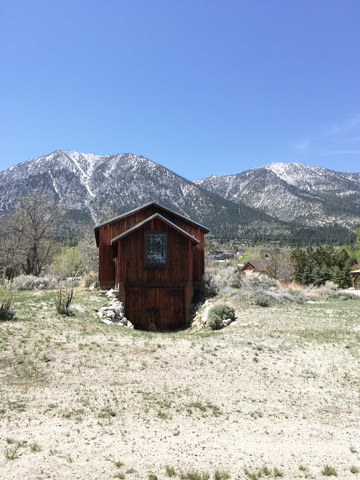A Visit to the Sheridan House
Few traces are left of the once-bustling settlement of Sheridan, Nevada. So it was an amazing privilege to be invited to visit the privately-owned Sheridan House, one of the town’s early hotels!
The Sheridan House is thought to date to the early 1860s. Back in the day, it was one of two hotels in town, situated right on the Emigrant Trail. And the early settlement at Sheridan was a bustling affair. A festive saloon once sat just south of the Sheridan House hotel. Slightly to the north stood a grist mill and early blacksmith shop, and other buildings and residences.
The blacksmith shop, saloon, and most other buildings that once formed the small settlement have now vanished. But the early grist mill still stands – and a babbling creek still feeds what used to be the mill-pond.


Moses Job’s early store was likely the first building erected here, about 1855. Job sold the property in 1861 to J.W. Haines and I.W. Duncan. Although it’s unclear exactly when the Sheridan House itself was built, it may have been erected during Haines’ tenure to serve passing emigrants.
And it wasn’t just travelers who enjoyed the hotel. The Sheridan House quickly became a hub for the local community. A ball was held at Sheridan House in November, 1876, for example, offering a “good supper [and] music.” Marriages took place here. And locals enjoyed the wares of the hotel bar and its adjacent saloon.


Later owners of the Sheridan House property included H.D. Allerman; William Gansberg and his family; Diane Gordon and Dorothy Colley; Dr. Dunn; and Tom and Kathy Hart. Today it remains a private home, tucked away securely behind a security gate. Current owners P.J. and Allan Sapp have happily called the Sheridan House their home for more than twenty years.
A few changes have taken place over all those years, though the stately two-story home retains all its historic charm. Modern conveniences like electricity were added, and the out-house is no longer in use. “I was told this was the first house in Carson Valley to have indoor plumbing,” smiles owner P.J. Sapp.

The original kitchen, once attached to the back of the house, was moved a short distance several decades ago to become a bunkhouse for ranch workers. That old kitchen building still stands, now repurposed as a guest house. Inside the main home, a long room once used for dining and dances has become the kitchen/dining area.
Subsequent owners have left their own artistic touches on the property. Colorful stained glass accents and leaded glass doors were added by artist Diane Gordon. Dr. Dunn created a whimsical “valance” for the windows of his office out of fence rails that had been chewed by his horses!

“The people who’ve owned the house through the years have respected it,” says P.J. “We capped the brick chimneys, for example. But we kept them where they were, even though they’re not used now.”
The early grist mill, too, has been preserved. Built in a “bank-a-hill” style to take advantage of the sloping terrain, the grist mill may date to the early 1860s as well, though its age is uncertain. In later years, the upper level of the grist mill became a “carriage house” to store farm equipment, with potatoes and other perishables stored in the cool section below. In wintertime, the nearby mill-pond was a favorite spot for locals to go ice skating.



Traces of the Sheridan House’s early history continue to surface. The Sapps have discovered square nails in the original floor planking, for example, and square nails keep turning up outside. Horseshoes, a perfume bottle, and other artifacts have been uncovered on the property. Perhaps the most special memento of all: a metal token stamped with the words, “Good for 1 drink at the Sheridan Hotel.”

Despite the passage of time, much about the early hotel happily hasn’t changed at all. Just as it did a century and a half ago, the Sheridan House still sits on decomposed granite – with no concrete foundation. The windows in the music room still feature their original wavy glass.
And the front door still looks out on a magnificent view of Carson Valley – and the road that was once the Emigrant Trail.

_________________
